Determine the Sex of Birds Using DIY DNA Testing
Use molecular biology to tell male and female birds apart
Use molecular biology to tell male and female birds apart
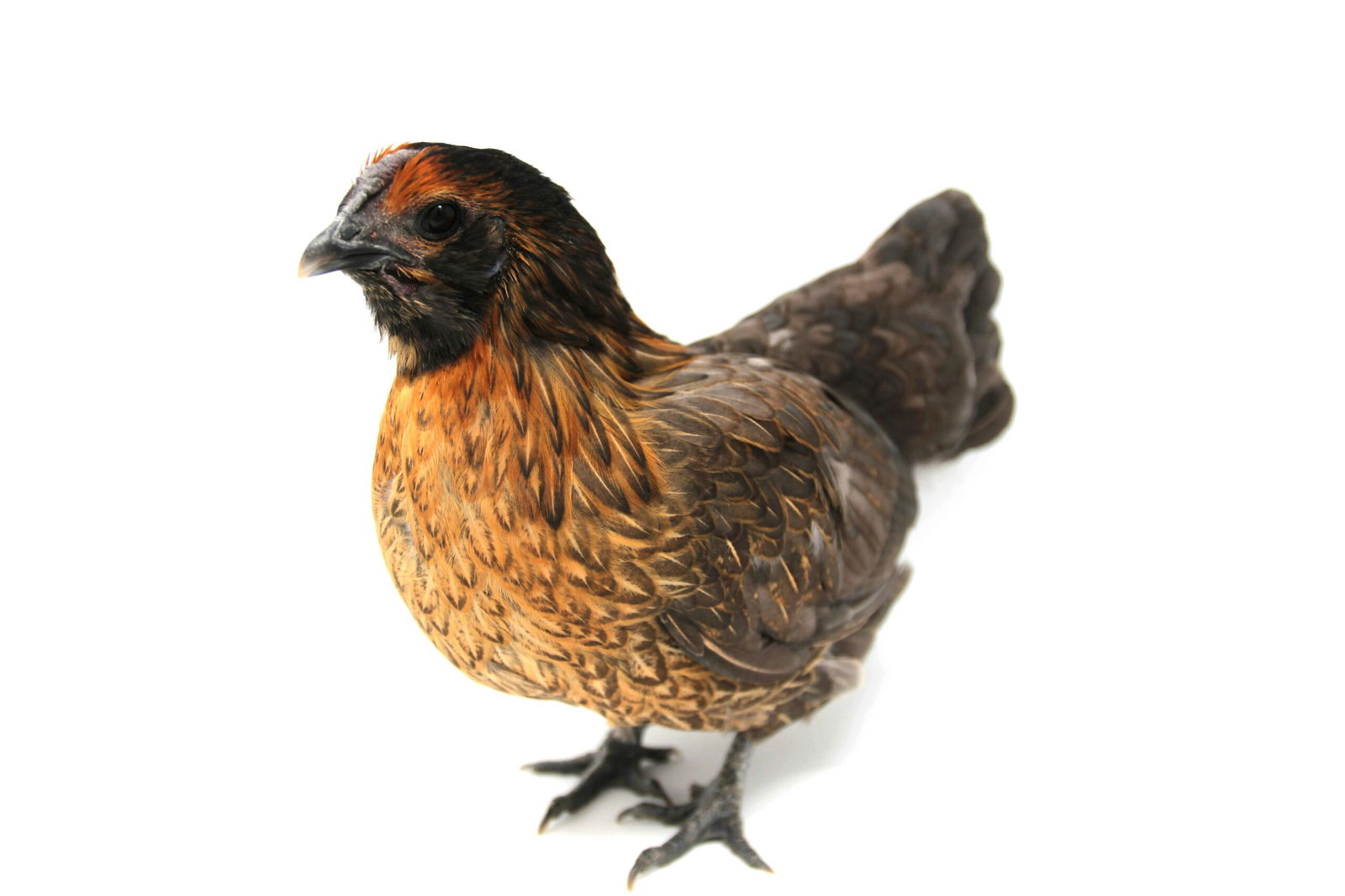
DNA bird sexing provides a reliable alternative to visual or behavioral identification when gendering chicks or older birds.
Many bird species are sexually monomorphic, meaning males and females look identical, making visual sexing unreliable.
DNA testing determines a bird’s sex by analyzing its genetic material. The process involves extracting DNA from a feather, eggshell, or blood sample and identifying the bird’s sex chromosomes (Z and W) using a method called PCR.
Determining a bird’s sex through DNA testing can be done in two ways, depending on your budget, timeline, and preference.
You can send samples to a DNA testing service for external analysis, or you can opt for the DIY approach using a DNA sexing kit to analyze samples at home.
If you’re testing many birds and want to reduce long-term costs, DIY is the most cost-effective choice after the initial equipment investment. However, if you’re testing a few birds or prefer a hassle-free process, an external service offers quick results with no need for technical setup.
| DNA Testing: External Service | DNA Testing: Do-It-Yourself |
|---|---|
| Higher cost per sample ($15 – $30) | Lower cost per sample ($1.50+) |
| Results within days (3–7 days) | Results within hours (3–5 hours) |
| No equipment required | Initial investment into equipment and learning required |
Answer 3 quick questions to find the best DNA sexing method for your birds and get a personalized recommendation.
With the right tools, you can determine a bird’s sex yourself using a straightforward DNA analysis process. Our collection of bird sexing workflows shows you how to extract DNA from feathers, and how to identify the sex of birds using our Bird Sexing Materials Kit and portable equipment, Bento Lab.
The results are easy to interpret: Two bands = Female. One band = Male.

See each step of the DNA extraction process using Bento Lab, from feather to result.
Curious about getting started with DNA testing? Browse our guides, or get in touch with our team — we’re happy to explain the process.
Here’s a quick overview of what you’ll need to get started. You can find a more detailed list in our guide What do I need to set up a lab for bird sexing? and on our protocols.
You’ll need pipettes to handle liquids, and PCR equipment (a Bento Lab or equivalent) to run the DNA tests and visualize the results.
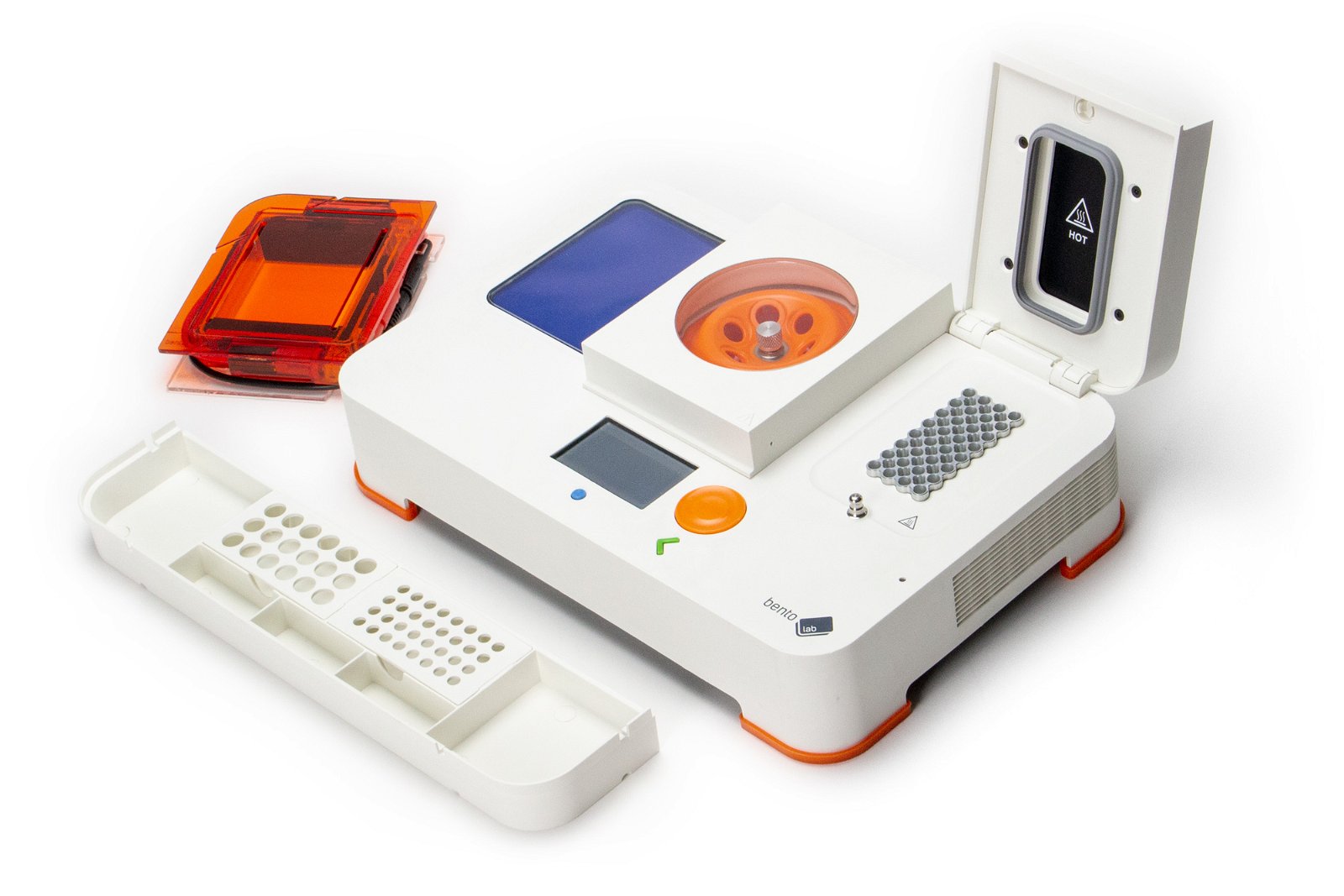
You’ll need materials to test each sample – reagents for DNA extraction and PCR, and plastic consumables like tubes, pipette tips, and agarose gel for electrophoresis.
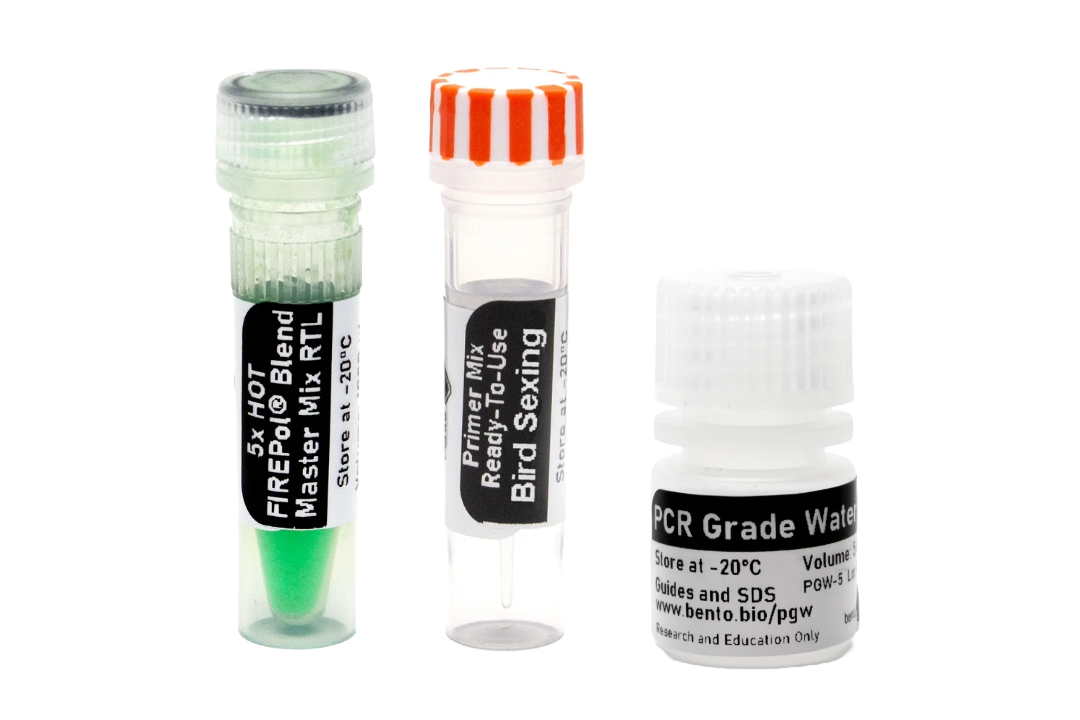
Our visual protocols take you go through the workflow. If you are new to lab techniques, there can be a learning curve. We offer support by email, and we also offer 1:1 online training.
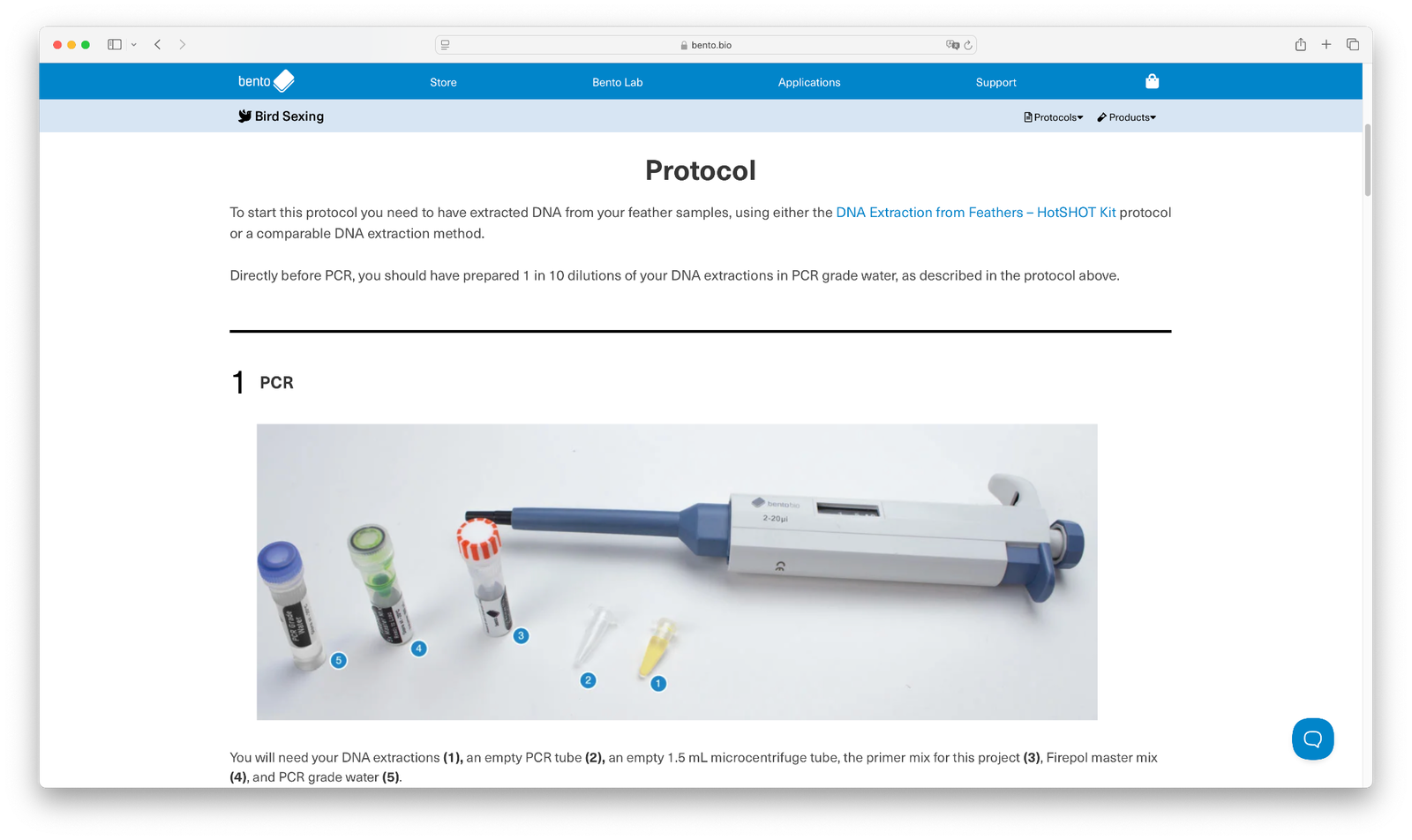
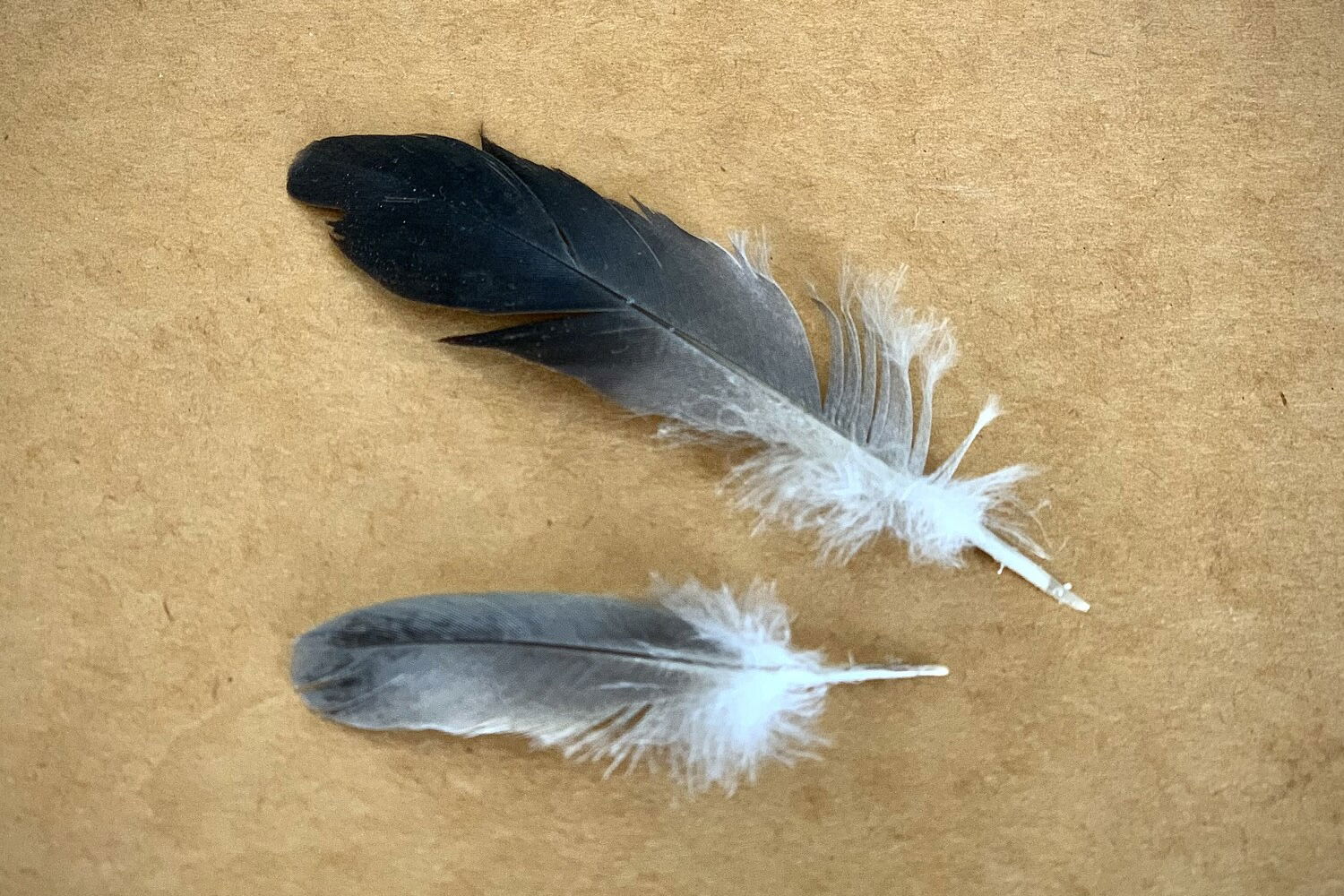
Prefer to learn independently? Our detailed visual guides walk you through each stage of the DNA sexing workflow — from feather collection to interpreting your results.
You can explore the full workflow and protocols online. And if you get stuck, we’re happy to help with questions by email.
Let me just say that your service and products were excellent — you were the best company we dealt with.
Karen, UK – April 2025
Want support to confidently determine the sex of your birds using DNA testing? Our 1:1 training sessions will teach you everything you need to know — from collecting samples to analyzing results with Bento Lab.
Our training course covers:
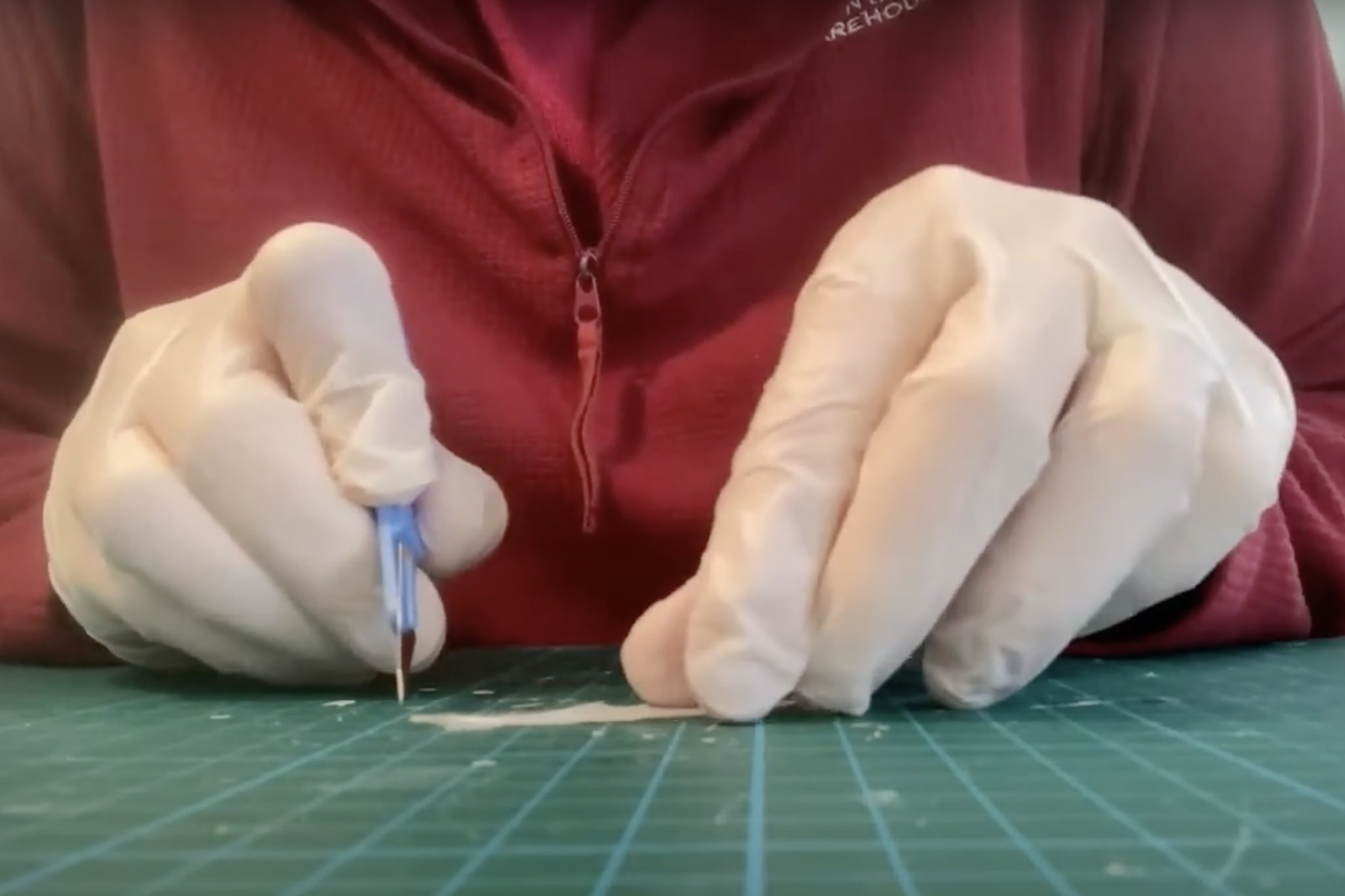
If you’re new to DNA sexing, these answers will help you understand why it’s useful, how accurate it is, what you need to get started, and more. Whether you’re wondering about sample collection or costs, this FAQ covers the key points to get started. If you have other questions, get in touch with us.
Many bird species are sexually monomorphic, meaning males and females look identical. DNA sexing provides a fast, accurate, and non-invasive way to determine sex without relying on physical traits.
DNA testing is over 99% accurate when performed correctly. It identifies a bird’s sex by detecting differences in genes found on the sex chromosomes.
Many bird species can be sexed using this method. The most common approach (based on the CHD1 gene) works for a wide range of species, and we also provide a few alternatives for cases where CHD1 test may not be suitable.
To find out if your bird species is supported, check our searchable guide:
Choosing a DNA Primer Set for Bird Sexing
If your species isn’t listed, or you’re unsure, feel welcome to get in touch with us — we’re happy to offer advice.
Feathers, blood, or eggshell can all be used for DNA sexing. Feathers are generally the least stressful and easiest to collect, making them a popular choice.
For feathers, gently pluck 2-3 from the chest or underwing. For blood, a tiny drop from a clipped nail is enough. Always follow ethical handling guidelines to minimize stress.
We recommend getting our Bird Sexing Bundle and Bento Lab, which will equip you with almost everything you need, apart from a few standard items like water, gloves and paper towel.
All the reagents, consumables and equipment you need in order to follow the DNA Extraction from Feathers and Bird Sexing Protocol are listed below.
Reagents
Consumables
Equipment
Once you have equipment, the cost can be as low as $2 USD per sample for the materials – depending on which materials you use, and if you’re processing multiple samples at once. We would suggest starting small, and estimating about $5 USD for materials per sample at the very start.
We have put together a spreadsheet calculator if you want to calculate how the costs change with different quantities of samples.
If you have any questions or feedback about the spreadsheet, please get in touch. We are happy to discuss costs via email.
You can learn to do it yourself without training.
Bird DNA sexing is a reasonably complex process that involves careful sample collection, DNA extraction, PCR, and gel electrophoresis. If you’re new to molecular biology techniques, some steps can be tricky at first, but many people have successfully learned to do it themselves.
Our resources are designed to be as beginner-friendly as possible, and many users get great results by following them independently. If you get stuck, we’re happy to help by email.
If you prefer hands-on guidance or want to build confidence with expert support, our optional training course walks you through the entire workflow step-by-step, making the learning process smoother and more accessible.
Birds have two sex chromosomes known as Z and W. These are similar to the X and Y sex chromosomes in humans – each inherited from one parent. Male birds have two copies of the Z chromosome (ZZ) and females have one copy of the Z chromosome and one copy of the W chromosome (ZW). This is the opposite of the situation to humans, where most biological females have two copies of the X chromosome (XX) and most biological males have an X and a Y chromosome (XY).
This PCR workflow involves the CHD1 (Chromodomain Helicase DNA Binding Protein 1) genes, which are present on the W and Z sex chromosomes of birds as two variants – CHD1-W (on the female-specific W chromosome) and CHD1-Z (present in males and females on the Z chromosome). These genes are homologous (almost identical in structure and function) but contain introns (DNA that is removed by RNA splicing before it is translated into mature RNA) that usually differ in length between sexes within a species and between species.
This difference in length allows both sexes to be determined using a simple assay based on intron length differences. Once DNA has been extracted, regions within the CHD1-Z and CHD1-W (if present) genes can be amplified using the polymerase chain reaction (PCR), and the amplified DNA visualised on an electrophoresis gel. If only one band is present, this suggests that only one CHD1 coding variant is present (CHD1-Z), which would be expected for a male with a ZZ chromosome pair. If two bands are present, this suggests that both CHD1-Z and CHD1-W genes are present, which would be expected for a female with a ZW chromosome pair.
The advantage of amplifying both variants (if present) together is that the band produced by the CHD1-Z should always be visible – it will only be absent if the DNA extraction or PCR fails. It therefore acts as an individual positive control for each specimen.
There are two possible results for most birds:
Female: One copy of the CHD1-Z gene is present on the Z chromosome, and one copy of the CHD1-W gene is present on the W chromosome. The target amplified regions of these genes are generally different in length and will be visible on an electrophoresis gel as two distinct bands.
Male: Two copies of the CHD1-Z gene are present – one on each of the Z chromosomes. The amplified regions of these genes are almost always identical in length and will be visible on an electrophoresis gel as a single band.
There are two primer sets that are commonly used for bird sexing as they can successfully sex birds belonging to many, but not all, taxonomic groupings. These are CHD1F paired with CHD1R, and 2550F paired with 2718R.
When these primers are used to amplify regions of the CHD1-W and CHD1-Z genes from DNA extracted from a female and a male chicken, they produce different amplicons for each sex as can be seen below: two distinct bands for the female specimen, and only one band for the male specimen.
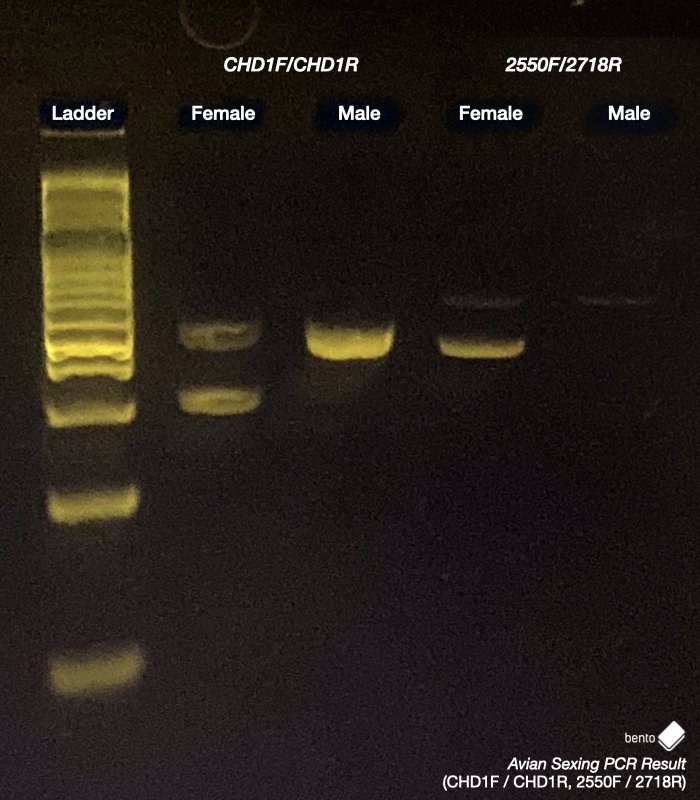
For both primer sets, there are two distinct bands for the female chicken and only one band for the male chicken.
Have questions about getting started? Book a call with us – our science team are happy to talk you through the workflow, and answer questions.